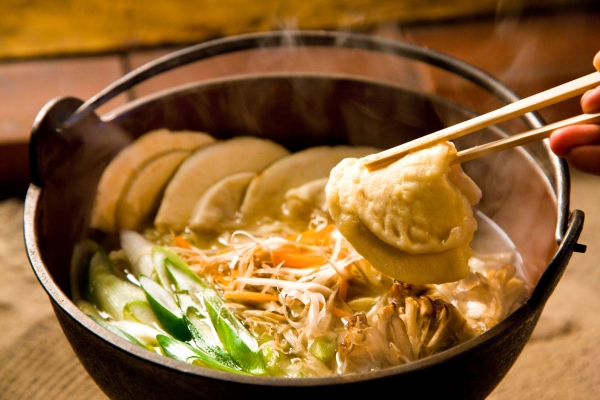Soup up your Tohoku travels: 6 unique must-try soups in Tohoku

On a cold rainy day, don’t you just love a hot bowl of soup to warm you up from the inside? When we think about Japanese soups, most people can only think of miso soup. While miso soup is a staple in most Japanese meals, there are actually quite a variety of Japanese soups and stews that cannot be found elsewhere. The Tohoku Region has quite a number of unique soup dishes, probably due to its colder climate. Let’s explore some of their unique specialty soups, one from each of Tohoku’s six prefectures!
1. Kiritanpo Nabe in Akita Prefecture

Eating these delicious food over a hearth in winter warms you right up (Image credit: JNTO)
Akita Prefecture (秋田県 Akita-ken) is famous for quite a few foods that are uniquely found in the prefecture. One of them is the Hinai Jidori, a breed of chicken native to Akita. Another is Kiritanpo (きりたんぽ), which is simply rice pressed on a stick like a tandoori skewer then lightly toasted over a hearth. These two ingredients are often eaten together in a savoury-sweet soy sauce broth with burdock roots and other local vegetables. When you go to Akita, definitely do not miss out on this.
2. Senbei Jiru in Aomori Prefecture

These wheat crackers turn into delicious chewy goodness when they absorb all that flavourful broth. (Image credit: APTINET Aomori Prefecture)
Because of the cold weather, people in the Tohoku Region in the past could not cultivate rice as well as those in the warmer southern parts. Instead, they cultivated wheat and made senbei with the wheat flour. Senbei Jiru (せんべい汁) comes from Hachinohe in Aomori Prefecture (青森県Aomori-ken) where their famous Nanbu Senbei (南部せんべい wheat crackers) are added into soups and stews. The senbei made today have been perfected such that they retain a certain chewiness even when thoroughly soaked in delicious broth and will neither turn soggy nor disintegrate! Every restaurant in Hachinohe serves their own version of this local dish, so if you can, try them all.
3. Ichigoni in Iwate & Aomori prefectures

A simple looking soup but hidden within is an explosion of flavours! (Image credit: APTINET Aomori Prefecture)
Ichigoni (いちご煮) is a soup that originated from the east coast of Iwate (岩手県 Iwate-ken) and Aomori prefectures. This humble dish is made from fresh sea urchin and abalone caught from the Pacific Ocean and cooked in a dashi broth. Usually, just a little salt is added to the simple-looking soup—it requires very little seasoning as the soup is already packed with flavour from the fresh seafood. Nowadays, it is easy to find them all over Hachinohe so you can easily order one when you get into any izakaya within the city.
4. Imoni in Yamagata Prefecture

The locals are as warm as the broth – if they spot you, they will invite you to join them for a bowl of this delicious stew! (Image credit: f_a_r_e_w_e_l_l / CC BY-SA 2.0)
This hearty stew can be found in all of Tohoku but the most famous variety belongs to Yamagata Prefecture (山形県 Yamagata-ken). The main ingredients used are satoimo (里芋 taro), beef or pork, konnyaku (こんにゃくkonjac), and soy sauce. When the weather starts turning cold, people gather near rivers to prepare imoni (芋煮) together in the great outdoors. Convenience stores in the prefecture even stock up on firewood and other supplies just for the occasion.

The pot is so HUGE that it is stirred using excavators! (Image credit: Yamagata Prefectural Government)
Through September and October annually, it is common to see groups of people gathering to have these imoni parties called imonikai (芋煮会) in the prefecture and travellers are always welcomed with a piping hot bowl of delicious stew. However, the most amazing imoni party would be the Yamagata Imoni Festival (日本一の芋煮会フェスティバル Nihon ichino imonikai fesutibaru) where they make one single GIGANTIC pot of imoni that can serve 30,000 people and the pot is stirred using excavators!
5. Sendai Zōni in Miyagi Prefecture

(Image credit: Miyagi Prefectural Government)
While you can find zōni (雑煮) pretty much anywhere in Japan during the New Year, you can only find this luxurious goby zōni in Miyagi Prefecture (宮城県 Miyagi-ken). Many freeze-dried vegetables and dried gobies are used to make the soup extra flavourful. The soup is then topped with freshly-grilled goby, Sendai’s famous Kamaboko fishcakes, and glistening pearls of salmon roe!
Some restaurants serve this Sendai specialty all year round. Besides Gyutan and Zunda, Sendai has a lot of other different unique and yummy dishes to try out. Make sure to try this soup, especially if you are there during the New Year’s period.
6. Kozuyu in Fukushima Prefecture

Each family has their own Kozuyu recipe. You can make your own as well! (Image credit: Opqr / CC-BY-SA-3.0)
This specialty soup kozuyu (こづゆ) from Aizu in Fukushima Prefecture (福島県 Fukushima-ken) is eaten during special occasions like New Year’s. Ingredients usually include carrots, bamboo shoots, dried vegetables, dried seafood, wheat gluten, and konnyaku jelly noodles (しらたき shirataki).
Don’t let the soup’s seemingly clear and simple appearance fool you, though. Boiled with dashi, the dried foods’ umami is extracted into the broth—resulting in an unmatched explosion of flavours.
BONUS: Miso Curry Milk Ramen

The extremely rich soup is really good on a cold winter's day. (Image credit: APTINET Aomori Prefecture)
This otherworldly sounding combination was conceptualised by high-school students in Aomori Prefecture. This combination, which cannot be found anywhere else, features a blend of miso and milk with a dash of curry flavour. As if it weren’t rich enough, butter is usually added on top. Fortunately, it is eaten with vegetables like bean sprouts and seaweed. This rich and sinful soup noodles tastes especially heavenly during the long and cold winters in the region.
While these soups are really good, the Tohoku region has so much more to offer! It is a great place for sightseeing with its vast untouched nature and is especially picturesque in autumn. Read other articles on our site like Sue Lynn’s Naruko Gorge adventure to find out more about Tohoku’s beautiful sights.
Header image credit: APTINET Aomori Prefecture





